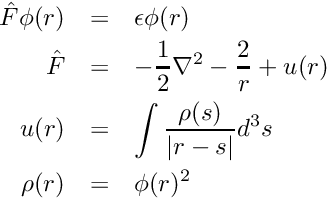The source is here.
- Points of interest
- application of the Coulomb and Helmholtz Green's functions
- smoothing of the potential and initial guess
- manual evaluation of the solution along a line
- Background
The Hartree-Fock wave function is computed for the helium atom in three dimensions without using spherical symmetry.
The atomic orbital is an eigenfunction of the Fock operator

that depends upon the orbital via the Coulomb potential ( 

- Implementation
Per the usual MADNESS practice, the equation is rearranged into integral form
![\[
\phi = - 2 G_{\mu} * ( V \phi)
\]](form_178.png)
where 

![\[
\left( - \nabla^2 + \mu^2 \right) G(r,r^{\prime}) = \delta(r,r^{\prime})
\]](form_181.png)
The initial guess is 
- computing the density by squaring the orbital,
- computing the Coulomb potential by applying the Coulomb Green's function,
- multiplying the orbital by the total potential,
- updating the orbital by applying the Helmholtz Green's function,
- updating the energy according to a second-order accurate estimate (see the initial MRQC paper), and finally
- normalizing the new wave function.
The kinetic energy operator is denoted by 



The source is here.